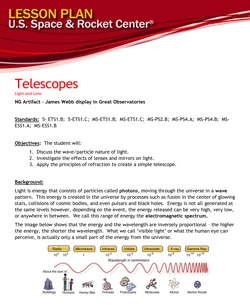Introduction
Welcome to the virtual outreach unit on telescopes from The U.S. Space and Rocket Center! We would like to thank the Northrop Grumman Foundation for their generosity in sponsoring the development of this unit. In this module you will find many resources that will help you provide an exciting and educational experience for your students. From introductory concepts, to career connections, in addition to activities and lesson plans, we hope you find everything you need for a successful teaching experience. Please see below for a detailed listing of the unit:
- Pre-Activity Resources– This document provides links to articles and videos that provide introductory information about telescopes; how they work and what they do.
- Interview with an Astrophysicist – This video highlights the career and educational experiences of the U.S. Space & Rocket Center’s own Planetarium Director, David Weigel.
- Activity – This document provides background information about light and the electromagnetic spectrum. There are instructions for an investigation into manipulating light and building a simple telescope. There is also a video that demonstrates the activity.
- Continue Learning– This document includes links to help continue engagement. The links include videos, and articles, as well as additional activities.
Pre-Activity Resources
Why Do We Put Telescopes in Space? (minutephysics)
Radio Waves - Tour of the Electromagnetic Spectrum (ScienceAtNASA)
Microwaves - Tour of the Electromagnetic Spectrum (ScienceAtNASA)
Infrared Waves - Tour of the Electromagnetic Spectrum (ScienceAtNASA)
Visible Light Waves - Tour of the Electromagnetic Spectrum (ScienceAtNASA)
Ultraviolet Waves - Tour of the Electromagnetic Spectrum (ScienceAtNASA)
X-Rays - Tour of the Electromagnetic Spectrum (ScienceAtNASA)
Gamma Waves - Tour of the Electromagnetic Spectrum (ScienceAtNASA)
Astronomically Correct Twinkle Twinkle (minutephysics)
Subject Matter Expert
Activity
Light is energy that consists of particles called photons, moving through the universe in a wave pattern. This energy is created in the universe by processes such as fusion in the center of glowing stars, collisions of cosmic bodies, and even pulsars and black holes. Energy is not all generated at the same levels however, depending on the event, the energy released can be very high, very low, or anywhere in between. We call this range of energy the electromagnetic spectrum. Download "Telescopes" activity (pdf)
This curriculum is made possible by the generous support of the

Continue Learning
NASA Interview: Dr Colleen Wilson Hodge (U.S. Space & Rocket Center)
NASA Interview: Dr Steven Ehlert (U.S. Space & Rocket Center)
NASA Interview: Dr Sabrina Savage (U.S. Space & Rocket Center)
Hubble Space Telescope: 30th Anniversary (U.S. Space & Rocket Center)
Straight Line Light Travel (U.S. Space & Rocket Center)
Reflection and Refraction - Science Never Stops (U.S. Space & Rocket Center)
World Wide Telescope Tutorial - Part 1 (U.S. Space & Rocket Center)
World Wide Telescope Tutorial - Part 2 (U.S. Space & Rocket Center)
World Wide Telescope Tutorial - Part 3 (U.S. Space & Rocket Center)


